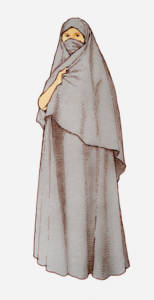A Brief History of Religious Veiling

With current efforts to ban religious veiling in public, it is important to understand the history of this practice.
With several Western nations experiencing increases in Muslim immigration, one major issue rising to the surface is religious veiling. Depending on the type of Islam they practice and the countries from which they originate, Muslim women might opt for simple headscarves, veiling that obscures their heads and shoulders, or complete body coverings. Current public discourse has sometimes resulted in legislation to ban religious veiling in public. Against the backdrop of such fevered discussions, it’s important to understand Islam is not the only faith in which people wear veils. In fact, the origins of religious veiling can prove to be rather surprising.
Religious Veiling in the Ancient Middle East
Racked contributor Liana Aghajanian revealed in a December 2016 piece that women all over the world have been wearing some form of head covering for more than 3,000 years. For instance, the practice was common throughout the ancient Levant region as well as Greece, Rome and regions located in modern-day Turkey, Iran and Iraq. Rather than signifying any devotion to religious piety, they originally denoted that the women who wore them belonged to these societies’ upper classes. Aghajanian discloses the discovery of a 13th-century Assyrian text forbidding anyone other than aristocrats from donning veils. Working class women, slaves and other lower-class individuals faced legally prescribed punishments if they were caught wearing them.
Head Covering and Religion in the Modern Era
It isn’t immediately clear how head coverings became associated with religious modesty, but they were eventually adopted by women of all socioeconomic classes throughout the Middle East. Traditions from the three major Abrahamic faiths soon dictated that veils should be worn. The University of North Carolina’s Center for European Studies explains that some Jewish people interpret their faith’s “tzniuth,” or laws on modesty, to mean that women’s hair should be covered. While the Bible’s New Testament records no commandments issued by Jesus Christ concerning the issue, Saint Paul upheld the practice in his first letter to the Corinthian church.
Meanwhile, various sects of Islam actually disagree over religious veiling. CNN writer Abed Awad disclosed in a June 2015 write-up that the Quran never explicitly mentions the word “veil.” Additionally, there are two general schools of thought on the matter resulting from different interpretations of customs said to be handed from Aisha, one of Muhammed’s wives:
Veil everything except for the hands, feet and face upon reaching puberty.
It’s a good idea to wear veils, but they are not obligatory.
Bill 62: The Latest in Veil Legislation
Recent Canadian news includes reports about Quebec’s Bill 62, which initially required the province’s residents to show their faces to provide or receive any sort of public services. The Globe and Mail clarified in December 2017 that this law, which would have impacted aspects of daily life such as riding public transit and visiting libraries, was temporarily put on hold by the province’s Superior Court. The Quebec law is certainly not the first of its kind. The Guardian revealed in March 2017 that Europe has an almost decade-long history full of repeated attempts to regulate the practice of religious veiling, and debates over the issue rage on south of our border. While advocates of these regulations cite public security worries, pushback ensues based on concerns about religious discrimination as well as the safety of women who opt to cover their heads. Muslims also hold views on both sides of the issue, with some opining that such bans are fueled by Islamophobia while others support measures to outlaw face covering.
Several factors prove that the issue of religious veiling in public isn’t as cut and dry as one might be tempted to believe. Religion, personal freedom, public safety and concerns about racial and religious discrimination all play into the larger discussion. Since Statistics Canada predicts that the number of Muslims will significantly increase by the year 2036, public debate may continue for some years to come.

